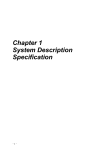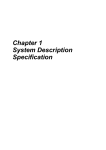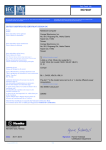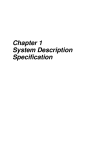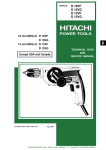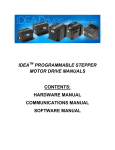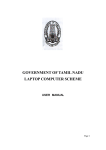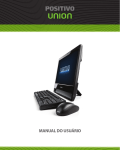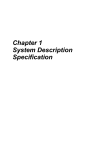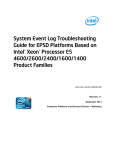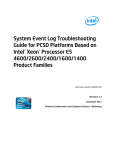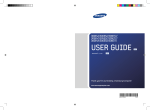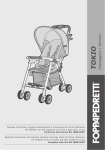Download VBL3X Service manual for WIN8
Transcript
Chapter 1 System Description Specification -1- 1. SCOPE This document describes the functional specifications for the Compal Notebook personal computer VBL30/31series. The system is hardware and software compatible with the IBM PN/ATX personal computer. 1.1 CPU Intel Sandy Bridge or Ivy Bridge based Celeron/Pentium Dual Core 1.7G/1.8G/1.9G/2.2G/2.3G/2.4G 1.2 Chipset HM70 or HM75 1.3 Memory Support DDR3-1333MHz 1G/2G/4G Support 2 So-DIMMS, up to Max. 8GB 1.4 Display 14”, 5.2mm, 16:9 LED backlight LCD HD 1366 x 768 1.5 Graphics Chip No (only for VBL30) AMD Radeon™ HD 7450M 1GB (DDR3 SRAM) (only for VBL31) 1.6 Audio HD Audio, Speakers (2*1.5W), Microphone-in and Headphone-out 1.7 Camera (Option) 1.0M Pixel CMOS Camera 1.8 Keyboard NAW20 chocolate-cap 86/87 keys support with 101/102 key emulation without stick-point Windows key, Application key Standard pitch, 2.5mm travel length Multi-Language support 1.9 Hard Disk Drive (HDD) 2.5" 9.5mm SATA HDD 250G/320G/500G (5400/7200rpm) 2.5" 7.0mm SATA HDD 320G/500G (5400rpm) 250G/320G/500G (5400/7200rpm) 2.5" 7.0mm SATA HDD 320G/500G (5400rpm 1.10 Optical Disc Drive (ODD) Fixed 12.7mm height tray SATA ODD DVD Super-Multi (DVD-RAM/-R/-RW/+R/+RW), 8X write Support Double Layer Recording is required 1.11 Communication No modem No WWAN LAN: 10/100 (Option), 10/100,1000 Giga LAN WLAN only or W/L+BT Combo (Option)(WLAN-AMP enabled for BT3.0 compatible) Note: For Motorola Bluetooth, please experience the BT function by Motorola's user friendly GUI, you can refer to Motorola BT help file from Taskbar -> Bluetooth icon --> Right Click on BT icon --> My Bluetooth Settings --> Help 1.12 Pointing Device Normal Track Pad with up/down scroll zone and two buttons Support Multi-finger feature 1.13 Media Slot 3-in-1 flash card reader (SD,MMC,MS) 1.14 I/O Ports 3 USB2.0 x 2(For HM70) USB2.0 x 3 (For HM75) USB3.0 x 1(For HM70) RJ45 x 1 VGA port x 1 HDMI x 1 3-in-1 flash card reader x 1 Microphone-in x 1 Headphone-out × 1 1.15 Microphone Analog Type Internal Microphone 1.16 TV tuner NO 1.17 System Status Indicators 1 Caps Lock (White) 1 Power Button LED (White) 1 LED for IDE HDD activity (Blue) 1 LED for System status (Power On / Suspend) (Blue) 1 LED for Battery status (Charging / Full / L1 / L2) (Blue/Amber) 1 LED for Blue tooth/Wireless Card (Amber) 1.18 Control Button Hot Key Power button (support software off, 4 sec)x 1 Magnetic lid switch control for system standby/ wakeup or suspend/ resume 1.19 User Keys No 1.20 AC Adapter Universal AC adapter 65W with 19V DC/3 pin 240V AC cable 1.21 Battery 6 cell Li-On, 18650 type, 4400mAh/ 4500mAh/ 5100mAh/ 5200mAh Life Cycle: 70% Design Capacity after 300 Cycles in 25degreeC 1.22 Software Insyde BIOS Suspend to DRAM/HDD Security: Power-On Password, Supervisor Password USB memory Boot support Support SMBIOS 2.4, PCI2.2 Support PXE Wake on LAN from S3 Wake on LAN from S4 /S5 in AC mode 1.23 OS Windows 8 x64 1.24 Mini Card One Mini card slot for WLAN Half size card 1.25 Security BIOS Password / Kensington lock 1.26 Regulatory EMI: FCC-B, CE, VCCI, BSMI Safety: BSMI ,CB 1.27 Environment Temperature: Operating: 5 - 35°C / Storage: -20 - 65°C Humidity: 10 - 90% without condensation Altitude: Operating sea level up to 10,000 ft Storage sea level up to 40,000 ft 1.28 Thermal Thermal capacity could support TAT TDP% or 3Dmark2006 operation at 35C ambient 1.29 Application 5 Driver CD W/User Manual 2. Mechanical Specification FOR 14" Notebook 344mm(W)*237.5mm(D)*19.7mm(H Front) &33.3mm (H Rear) 2.2Kg(including: HDD, DVD, and BATT module) 2.1 Option Pack: AC adapter : HDD Pack : BATT (Li-ion) : 317.3(6cell) BATT (Li-ion) : 355g(6cell) DVD module: 360.9g 122.9g(9.5mm) 217.1g 2.2 Mechanical Function Removable HDD. Module (DVD, BATT ) Battery changeable (Li-ion). For security can use Kensington Lock. Scissor type key board standard pitch 3.0 m/m travel length. 2.3 Mechanical Material -6- Plastic PC+ABS (Mitusbishi /8906C9-MB8800) Mitusbishi/BK30-TMB1615 ABS+PC+15% TALC BABYER DP3002 PC+ABS Chapter 2 Software Specification -1- 1. System Components Summary Dimension Weight CPU Chipset Memory 344 x 237.5 x 19.7mm (Front) &33.3mm (Rear) 2.2 Kg Intel Sandy Bridge Dual Core 1.7G/1.8G/1.9G/2.2G/2.3G/2.4G HM70 SupportDDR3-1333MHz 1G/2G/4G Support 2 So-DIMMS, up to Max. 8GB Dummy ODD / Fixed 12.7mm height SATA ODD DVD Super-Multi (DVD-RAM/-R/-RW/+R/+RW), 8X write Optical Device (Option) Support Double Layer Recording is required High Definition Disc 2.5" 9.5mm SATA HDD SATA HDD 250G/320G/500G (5400/7200rpm) HDD 2.5”7.0mm SATA HDD 320G/500G(5400rpm) 250G/320G/500G (5400/7200rpm) 14”, 5.2mm, 16:9 LED backlight LCD Display HD 1366 x 768 Graphics Chip No 10. Audio HD Audio, Speakers (2*1.5W), Microphone-in and Headphone-out No modem No PCI-Express Communication No WWAN LAN: 10/100 (Option), 10/100,1000 Giga LAN WLAN only or W/L+BT Combo (Option) (WLAN-AMP enabled for BT3.0 compatible) NAW20 chocolate-cap 86/87 keys support with 101/102 key emulation without stick-point Keyboard Windows key, Application key Standard pitch, 2.5mm travel length Multi-Language support Normal Track Pad with up/down scroll zone and two buttons Pointing Device Support Multi-finger feature Media Slot 3-in-1 flash card reader (SD,MMC,MS) USB2.0 x 2 USB3.0 x 1 RJ45 x 1 VGA port x 1 I/O ports HDMI x 1 3-in-1 flash card reader x 1 Microphone-in x 1 Headphone-out × 1 Camera (Option) 0.3M/ 1.3M Pixel CMOS Camera Microphone Analog Type Internal Microphone TV tuner No 1 Caps Lock (White) 1 Power Button LED (White) System Status 1 LED for IDE HDD activity (Blue) Indicators 1 LED for System status (Power On / Suspend) (Blue) 1 LED for Battery status (Charging / Full / L1 / L2) (Amber/Blue/Amber) 1 LED for Blue tooth/Wireless Card (Amber) Hot Key Control buttons Power button (support software off, 4 sec)x 1 Magnetic lid switch control for system standby/ wakeup or suspend/ resume User Keys No AC Adapter 65W 6 cell Battery Li-On, 18650 type, 4400mAh/ 4500mAh/ 5100mAh/ 5200mAh Life Cycle: 70% Design Capacity after 300 Cycles in 25degreeC -2- Software OS Mini Card Security Regulatory Environment Thermal Application -3- Insyde BIOS Suspend to DRAM/HDD Security: Power-On Password, Supervisor Password USB memory Boot support Support SMBIOS 2.4, PCI2.2 Support PXE Wake on LAN from S3 Wake on LAN from S4 /S5 in AC mode Windows 7 Ultimate 32bit One Mini card slot for WLAN Half size card BIOS Password/ Kensington lock EMI: FCC-B, CE, BSMI Safety: Compliant to UL, CB, BSMI WHQL LOGO Temperature: Operating: 5 - 35°C / Storage: -20 - 65°C Humidity: 10 - 90% without condensation Altitude: Operating sea level up to 10,000 ft Storage sea level up to 40,000 ft 1. Thermal capacity @ 28 C ambient: a. Execute TAT TDP% CPU no throttling 2. Components @ 35 C ambient: a. Execute TAT TDP% , all components pass thermal spec 3. Skin spec. @ 25 C ambient: Execute 3DMark2006 a. Logic lower < △T= 28 deg. C b. Touch pad < △T=13 deg. C c. Palm rest & Keyboard < △T=15 deg. C d. Strip cover < △T=25 deg. C e. LCD bezel < △T=25 deg. C Driver CD W/User Manual 2. System Controls 2.1 Buttons 2.1.1 Power Button The activity of the power button is as follows: If system is Off/Hibernate: System will be turned on while Power switch is depressed by more than 100 ms If system is in Standby state: System will resume while Power switch is depressed by more than 100 ms. If system on with legacy mode: depress this button will turn off power. If system is running in ACPI OS, the power button acts as the sleep button, and let OS controls the policy of power button which is defined in Power Option under the OS. 2.1.2 Power Button Over-ride Holding down the Power Button for 4 seconds will cause an unconditional transfer to the off state without notifying the operating system. 2.1.3 Lid switch If the system is running under legacy mode: Closing the lid will turn off LCD backlight. If the system is running under ACPI mode: The operating system will determine what action to take when the lid is opened and closed. The function of lid switch will follow the OS setting in power management (Nothing, Standby or Hibernate). If nothing, the backlight must turn off when the lid is closed. 2.1.4 System status indicators Please refer to Keyboard BIOS specification. -4- 3. Core BIOS Features 3.1 Multi Boot The notebook can support Multi-Boot for selecting the boot sequence of Hard Drive, Removable Devices, CD-ROM/DVD Drive and Network in Setup. 3.2 Quiet Boot Quiet Boot replaces the customary technical messages during POST with a more visually pleasing and comfortable display (OEM screen). During POST, right after the initialization of VGA, The notebook displays an illustration called the OEM screen during system boot instead of the traditional POST screen that displays the normal diagnostic messages. The OEM screen stays up until just before the operating system loads unless: <Esc> have no function on POST. Pressing <F2> to enter Setup. Pressing <F12> to enter Boot Menu. Whenever POST detects a non-terminal error, it switches to the POST screen near the end of POST, just prior to prompting for a password. If the BIOS or an option ROM request keyboard input, the system switches over to the POST screen with prompts for entering the information. POST continues from there with the regular POST screen. 3.3 Boot Block The Flash ROM used in many systems today offer the customer the advantage of electronically reprogramming the BIOS without physically replacing the BIOS ROM. This advantage, however, does create a possible hazard: power failures or fluctuations that occur during updating the Flash ROM can damage the BIOS code, making the system unbootable. To prevent this possible hazard, many Flash ROM include a special non-volatile region that can never be erased. This region, called the boot block, contains a fail-safe recovery routine. If the boot block finds corrupted BIOS, it prompts the end user to insert a diskette, from which it loads several files that replace the corrupted BIOS on the Flash ROM with an uncorrupted one. -5- 4. Thermal management Please refer to Keyboard BIOS specification. -6- 5. Power Management for ACPI mode 5.1 Introduction The notebook supports ACPI. The system will dynamically switch to ACPI mode for configuration and power management when an ACPI OS is loaded. When ACPI is not loaded and enabled, the power management function will be disabled. 5.2 System Time-outs If the system is running in ACPI mode, system Time-outs is handled by the operating system. BIOS time-outs are disabled. System time-outs are set using the control panel power applet. 5.3 System Power Management The overall system can be in one of the system power states as described below: ACPI mode Power Management Mech. Off (G3) All devices in the system are turned off completely. Soft Off (G2/S5) OS initiated shutdown. All devices in the system are turned off completely. Working (G0/S0) Individual devices such as the CPU and hard disk may be power managed in this state. S3 Sleeping State CPU set power down VGA Suspend New Card Suspend Audio Suspend Hard Disk Power Down ODD Power Down Super I/O Power Down S4 Sleeping State System Saves all system states and data onto disk prior to power off the whole system. 5.4 Device Power Management Under ACPI mode, the device specific power management supported by this notebook includes the CPU throttling, monitor power management and the hard disk. 5.4.1 CPU power management ACPI mode The operating system detects when the system is idle and places the CPU in one of the 3 CPU low power states (C1, C2, C3 up to C6) depending on how much latency it believes the system can afford. -7- The C1 state is simply the CPU halt instruction. The C2 state is the CPU stop grant state. The C3 state is the CPU stops clock state. The CPU stays in this state until an interrupt occurs. 5.4.2 Hard Disk The operating system uses the spin down timer of the hard drive to set time-outs. The BIOS time-out of the hard disk must be disabled in ACPI mode. The user can sets the hard disk spin down time-out in the control panel power applet. 5.4.3 Display Device The monitor can be turned off after a period of no activity based on the settings of the OS. 5.4.4 System Wake Up Sources The table below lists the wake up events for all low power states: Events S3 S4 S5 Process required Internal Keyboard Yes No No No Internal pointing device No No No No USB No No No No Lid Switch No No No No Power button Yes Yes Yes No LAN (On board) Yes Yes(AC mode only) Yes(AC mode only) Yes RTC Yes Yes(AC mode only) Yes(AC mode only) Yes Critical low battery Yes No No Yes Field „Process required‟ identifies that further process for the occurred events must be processed during wake up or resumes procedure. 5.4.4.1 LAN LAN (On board) S3(Standby): LAN is supported wake-up from S3 w/ AC/DC mode S4(Hibernation)/S5: LAN just only support wake-up from S4/S5 w/ AC only Real Time Clock Alarm The Real Time Clock alarm interrupt will wake the system from Standby (DC/AC), Hibernation (AC mode only) and S5 (AC mode only). Critical Low Battery Critical low battery event can wake the system from Standby (DC mode) in ACPI mode. 5.5 Hibernation -8- To support the hibernate state, the save to disk partition or file will be created by the operating system if the user select to enable the hibernation. It is the responsibility of the operating system to save the system state to a disk file and restore the system state when it is turned back on. -9- 6 ACPI (Advanced Configuration and Power Interface) 6.1 Introduction The Advanced Configuration and Power Interface (ACPI) is a well-specified power management and configuration mechanism. It evolves the existing collection of power management codes, APM, PnP BIOS, and Etc. 6.2 ACPI Sleep Status BIOS must support the following sleep states – S3, S4 and S5. 6.3 Fast Resume BIOS must hands off the control to the operating system within the following time limits: S3->S0 Required 2seconds *Measured using the Microsoft VTS (Velocity) tool. In addition, total resume time from S3 must be completed within 5 seconds. 6.4 Power State Transition Diagram The state transition diagram in ACPI mode is as follows: From (State) S3 Leave By Condition Power Button Internal Keyboard RTC Alarm On board LAN (WOL)(*1) Enter (State) S0 S3 Battery Critical Hibernation trip point reached (*2) The timer timeout after the inactivity of selected timer in power scheme, System Hibernate, reaches the setting (*2) Power Button On board LAN (Only in AC mode) RTC Alarm(Only in AC mode) S4 Power Button On board LAN (Only in AC mode) RTC Alarm(Only in AC mode) Press Lid switch / Sleep Button (Fn+F2) / Power Button (depends on ACPI OS setting) User selects the Standby Option in the Windows Shut Down menu ACPI OS timer expired Critical /Low battery (depends on ACPI OS setting) S0 Press Lid switch/ Sleep Button (Fn+F2) / Power Button (depends on ACPI OS setting) S4 S4 S5 S0 S0 - 10 - S0 S3 S0 User selects the Hibernate Option in the Windows Shut Down menu Critical /Low battery (depends on ACPI OS setting) Press Lid switch / Power Button (depends on ACPI OS setting) S5 The Power Button is pressed for 4 seconds (Power Button Override) User selects the Shut down Option in the Windows Shut Down menu Critical /Low battery (depends on ACPI OS setting) Thermal critical shutdown performed by EC firmware Note1: The backlight of LCD should be off when WOL from S3 as it is remote wake up. Note2: the S3 S4 transition results in the system transitioning to the S0 state first so OS can save the context to the hard disk. The system BIOS/KBC will not be involved for S3 S4 transition. The system power scheme will wake the machine from S3 and then transition to S4 Hibernation. The backlight of LCD is off during this transition. 6.5 Storage Devices and Batteries Possible storage devices are FDD, HDD, CD-ROM and DVD-ROM Floppy Disk and Hard Disk, CD-ROM and DVD-ROM The BIOS must report the correct types of these devices if the drive is installed in the system during POST. Two devices, which belong to the same category, are not supported in this notebook. Batteries The BIOS must follow ACPI specification and report the correct number of the installed battery and status. 6.6 Bootable Device The system is capable of booting from onboard HDD, CD ROM, DVD-ROM, external USB Floppy and USB ATA Flash device. 6.7 Embedded controller The keyboard controller will act as the ACPI embedded controller and support the ACPI EC protocol and interface. - 11 - 7. PC2001 The notebook must meet Microsoft Logo requirements in accordance with the PC2001 Guide and the Microsoft Logo test programs. - 12 - 8. Miscellaneous Features 8.1 BIOS ROM It depends on the platform design architecture (sharer ROM or Non-Sharer ROM, Intel ME SKU and so on). Non-Sharer ROM: SBIOS and EC BIOS have each SPI ROM chip separately, the EEPROM is inside EC BIOS area, BIOS will copy a full set of EEPROM data to SBIOS ROM at the first POST or EEPROM data is updated to speed up the EEPROM access. Sharer ROM: The EC BIOS, EEPROM and SBIOS are all inside one SPI ROM chip. 8.2 USB Support This feature allows the use of a USB keyboard to access BIOS Setup and to be used in DOS without additional drivers. USB floppy boot and Crisis Recovery from USB floppy is also supported. The driver provides other USB devices support after loading the operating system. 8.3 Flash utility – one ROM file only The flash utility can be used to program both system and keyboard BIOS at the same time Before flash BIOS you must make sure that AC exist. Or you will be forbidden to flash BIOS. 8.4 Crisis Recovery This feature provides an opportunity for system that cannot boot up. With a crisis floppy diskette, the system can perform crisis recovery by using internal PS2 keyboard. To perform crisis recovery using keyboard, do the following: Power off the system. Plug-in the USB floppy drive with crisis floppy diskette inserted. Hold down Fn + B keys. Plug-in AC adapter and make sure it is powered. Power on the system from off state (i.e. cold boot) while holding down <Fn+B> key. After POST, release <Fn+B> key. The system should boot from floppy and perform crisis recovery action. 8.5 VGA Support This section describes the expected behavior when a video monitor is connected to the VGA port on the notebook .The feature needs VGA driver support The BIOS will use both the RGB and pin 11 methods to determine the presence of an external VGA monitor. Video modes supported on the secondary display path (need VGA driver support) Supported video modes and timings please refer to the technical reference of VGA vendor. In particular, text mode and standard VGA modes are not supported. 8.6 Brightness table This section describes the LCD Brightness control. The keyboard Fn+F4 and Fn+F5 keys, the AC/DC state and the brightness slide bar in Windows Vista Mobility Center control the LCD brightness. - 13 - There shall be 11 levels of distinct brightness. Level 11 = Maximum Brightness possible. Level 1 = Minimum brightness without flickering (10 nits recommended, depending on inverter stability, type and display uniformity) *One setting level should be approximately 55 – 60 nits for Mobile Mark 2002 test. 8.7 Boot Display Algorithm This section describes the POST boot up display device with multi display device attached. Only support Local Flat Panel display during POST when LFP attached, the external display device (Include VGA, DVI, HDMI and DP) will not display until entering the OS. 8.8 Fast Boot The BIOS POST time should be within 5 seconds or less. The BIOS POST time is measured by Microsoft Velocity Test Suite. The POST timing test needs to include the worst-case drive configuration (internal or external) and worst-case memory configuration available via the retail channels. The POST time testing environment does not include attachable devices such as USB keyboards, external monitors, printers, PC Cards, Port Replicators and etc. For Win8, the BIOS POST time should be within 4 seconds or less. Note: if have TPM device, the BIOS Post Time should add extra 300 microseconds for initial. 8.9 Wireless Control BIOS should report the wireless device (include WLAN and BT) exist and enable status - 14 - 9. Customer Specific Features 9.1 Display of System Type and BIOS Version Number on Boot The development BIOS Version should start from 0.01 and the formal BIOS for MP should start from 1.00. 9.2 CMOS RAM management For UEFI Code, CMOS just reserve for kernel code/Chipset code, the variable storage had been replaced by flash part 9.3 CMOS Requirement for Debug Purpose For debug purpose, BIOS could save data to CMOS NV0 (access by port 70h/71h) offset 48h-4Fh, 6Ch-6Fh and 70h-7Fh, NV1 (access by port 72h/73h) offset 40h-57h and 60h-7Fh which are reserved for OEM use. 9.4 System Management BIOS(SM BIOS) version 2.7 (DMI 2.0) Limited DMI 2.0 BIOS information is provided: BIOS version number is type 0 data item. Type 1: System serial number – 64 alphanumeric characters with 12-character bundle number System manufacturer name – 16 alphanumeric characters System product name – 32 alphanumeric characters System version – 32 alphanumeric characters UUID – 32 Hexadecimal numbers Type 2: System manufacturer name – 16 alphanumeric characters Motherboard Product name – „XXX‟ System serial number – 64 alphanumeric characters with 12-character bundle number Type 3: System manufacturer name – 16 alphanumeric character System serial number – 64 alphanumeric characters with 12-character bundle number Asset tag number – 128 alphanumeric characters 9.5 Default SMBIOS Value Name System Serial Number Manufacturer name System version System product name - 15 - Default Value 123456789 Compal X.XX %project code% 9.6 EEPROM There is one EEPROM that is used to store many important system and user data in the notebook (some data are reserved for future to use)). The size of the EEPROM is 2K bytes. The EEPROM map is listing as below: Name System Serial Number Manufacturer name System version UUID System product name DMI type 11 Offset 00h – 1Fh 20h – 3Fh 40h – 4Fh 50h – 6Fh 70h – 7Fh 80h – 9Fh A0h – DDh Comments 32 bytes of Serial number. 32 bytes of Bundle number. 16 bytes for DMI type 1/2/3 32 bytes of System version for DMI type 1. 16 bytes for UUID for DMI type 1. 32 bytes of System product name. 62 bytes for DMI type 11 OS_SKU DEh 1 byte for OS type Unused DFh Unused GUID E0h – E7h 8 bytes for GUID Born On Date E8h – EAh 3 bytes for born on date EBh Set to AAh when the EEPROM get initialized. Reserved ECh- EFh Reserved Keyboard type F0h Define for US/UK/JP keyboard Keyboard BIOS used F1h 1 byte for Keyboard BIOS used EEPROM initialized flag Branding F2h 1 byte for Branding. KMS F4h KMS active flag Reserved for keyboard F5h – F6h Reserved 2 bytes for keyboard used Unused F7h – FDh Unused Assettag number 200h – 23Fh 64 bytes for DMI Type 3 LAN MAC Address 240h – 245h 6 bytes for LAN without EEPROM Unused 246h – 25Fh Unused ACPI OEM ID 260h – 265h 6 bytes for ACPI OEM ID Unused 266h – 26Fh Unused ACPI OEM Table ID 270h – 277h 8 bytes for ACPI OEM Table ID Reserved 278h 7FFh Reserved 9.7 OEM Active 1.0/2.0/2.1 and KMS activation Support - 16 - 格式化表格 OEM Activation 1.0 (a.k.a. SLP 1.0) is used to activate Windows XP. To support it, BIOS needs to populate OEM string in the 0xF000 segment during POST. OEM Activation 2.0 (a.k.a. SLP 2.0) is used to activate Windows Vista. To support it, BIOS needs to populate ACPI SLIC table during POST. For projects supports Windows 7, SLP 2.1 is required to support. For projects supports Windows 8, OA 3.0 is required to support. MS claims the Windows marker is MS‟s IP and cannot appear on non-Windows OS SKUs. An EEPROM flag OS_SKU (refer Sec. 9.4) is defined to indicate the machine is shipped with Windows or non-Windows OS. The flag is programmed in the factory and BIOS needs to read this flag when populating OEM string/ACPI SLIC table. If the flag indicates the machine is shipped with non-Windows OS, BIOS will not load Windows marker structure in ACPI SLIC table. KMS Activation support. To support the KMS activation, the SLIC table should be removed from the ACPI table. To support multi customer, BIOS should remove the SLIC table as default, and populate the SLIC table if customer enter the OEM ID, OEM table ID and OS_SKU in the EEPROM. The customer should create customized BIOS with SLP2.0/2.1 market and public key at the same time to active Vista/Window 7. Please refer to the “How to update OEM SLP” for the detail instruction of customized BIOS creation. 9.8 Multi Customer Logo Support To support Multi customer Logo, BIOS will merge dummy OEM logo in BIOS as default, and customer should create customized BIOS with OEM Logo. Please refer to the “How to update OEM Logo” for the detail instruction of customized BIOS creation. - 17 - 10. System Setup 10.1 Invoking setup The setup function can be invoked by pressing F2 During setup, all Fn function keys and power saving functions are disabled. The Secure Boot Menu can be invoked by pressing F3. 10.2 Setup screens 10.2.1 Main Menu InsydeH20 Setup Utility Main Advanced Security System Time System Date Boot Exit [00:00:00] [01/01/2011] Processor Type System Memory Speed Total Memory EC version System BIOS Version: Intel ME Version HDD Disk: CD/DVD Rom: Serial Number UUID Type,XXXGHZ XXXX MHz XXX MB X.XX X.XX.XX X.X.XX.XXXX XXXXXX XXXXXX XXXXXX XXXXXX F1 Help Esc Exit Select Screen Select Item F5/F6 Values Details see the following Help Information Change F9 Setup Defaults F10 Save and Exit System Time and System Date The hour is displayed with 24-hour format. The values set in these two fields take effect immediately. Processor Type This field shows CPU type and speed. System Memory Speed This field reports the memory speed of the extended memory with an integer in the system Total Memory This field reports the memory size of the extended memory with an integer in the system. HDD Disk This field reports the HDD string. CD/DVD Rom This field reports the CD/DVD string. Serial Number This field displays the serial number, max size support to 32 bytes. UUID - 18 - This field display the UUID, the length is 16 bytes. Help information System Time [hh:mm:ss]This is the help for the hour field. Vaild range is from 0 to 23. INCREASE/REDUCE:+/-. [hh:mm:ss]This is the help for the minute field. Vaild range is from 0 to 59. INCREASE/REDUCE:+/-. [hh:mm:ss]This is the help for the second field. Vaild range is from 0 to 59. INCREASE/REDUCE:+/-. System Date [mm:dd:yy]This is the help for the month field. Vaild range is from 1 to 12.(Error checking will be done against month/day/year combinations that are not supported.) INCREASE/REDUCE:+/-. [mm:dd:yy]This is the help for the day field. Vaild range is from 1 to 31.(Error checking will be done against month/day/year combinations that are not supported.) INCREASE/REDUCE:+/-. [mm:dd:yy]This is the help for the year field. Vaild range is from 2000 to 2009.( Error checking will be done against month/day/year combinations that are not supported.) INCREASE/REDUCE:+/-. 10.2.2 Advanced InsydeH20 Setup Utility Main Advanced Security Num lock Peripheral Configuration VT Configuration SATA as POST Hotkey Delay UMA Share Memory Size USB Legacy F1 Help Esc Exit Numlock Boot Exit <Off> <Enabled> <AHCI> <0> <64M> Details see the following Help Information <Enable> Select Item Select Screen F5/F6 Change Values Enter Select SubMenu F9 Setup Defaults F10 Save and Exit Enter this menu, you can choose the ON or Off in this submenu. Peripheral Configuration Enter this menu, it can display the submenu: “Bluetooth “Wlan - 19 - <Enable>” <Enable>” “Camera “Card Read “Azalia <Enable>” <Enable>” <Auto>” You can select Enabled or Disabled in the above submenu, and in the submenu “Azalia <Auto>” you also can select Auto, Enable or Disable. VT You can select the Disabled or Enabled in this menu. Configure SATA as Choose HDD mode through selecting the IDE mode or AHCI mode. UMA Share Memory Size You can select the share memory size for UMA use, 32MB/64MB/128MB/256MB/512MB could be selected. This select only showed on UMA unit. USB Legacy You can select the Disabled or Enabled in this menu according to the owner requests; Help information: NumLock Selects Power-on state for Numlock. Peripheral Configuration Configures the peripheral devices. Bluetooth/Wlan/Camera/Card Read/Azalia Enable or Disable this device, and in the submenu [Azalia <Auto>] you also can select Auto, Enable or Disable. VT Virtualization Technology Enable/Disable. Configure SATA As Set Harddisk Controller Configure Type. IDE/AHCI POST HotKey Delay Customizable amount of time for the user to press HotKey at POST. UMA Share Memory Size Select DVMT5.0 Pre-Allocated(Fixed) Graphics Memory size used by the Internal Graphics USB Legacy USB devices boot and access in DOS.If disable USB Legacy, USB device can not boot. 10.2.3 Security Menu This menu shows the security setting, such as TPM, User and Supervisor Password, HDD Password and Power on Password. InsydeH20 Setup Utility Main Advanced Security - 20 - Boot Exit Supervisor Password : Set Supervisor Password Power on Password F1 Help Esc Exit Clear Details see the following Help Information [Enabled] Select Item Select Screen F5/F6 Change Values F9 Setup Defaults Enter SubMenu F10 Save and Exit Select Supervisor Password Show the Password status: Clear or Set Set Supervisor Install or Change the password. Power on Password Enable or disable the Power on Password. You only can enable/disable Power on password after the Supervisor password is set. Help information Set Supeivisor Password Install or change the password and the length of password must be greater than one word and less ten words. Power on password Enable:System will ask input password on post time. Disable:System will ask input password when go to Setup Utility Password behavior Supervisor Password and Power on Password After set the supervisor password , power on password can enable or disable. If only set the supervisor password, system will request supervisor password before entering setup menu(F2). Users have 3 chances to input supervisor password, system will request shutdown if users input wrong password 3 times. If set power on password, system will request the password after power on the machine . Users have 3 chances to input power on password, system will request shutdown if users input wrong password 3 times. - 21 - 10.2.4 Boot Menu This menu allows the user to decide the order of boot devices to load the operating system. Bootable devices include the diskette drive in module bay, the onboard hard disk drive in module bay. The default Boot Type is “UEFI Boot Type”, the Boot page will show as below table: InsydeH20 Setup Utility Main Advanced Security Boot Exit Boot Type <UEFI Boot Type> Details see the following EFI Boot priority order: Help Information XXXXXXX Boot Device Status: Network boot <Enabled> PXE BOOT capability < UEFI:IPV4/IPV6 > F1 Help Esc Exit Select Menu Select Item F5/F6 Change Values F9 Setup Defaults Enter Select SubMenu F10 Save and Exit If the boot mode is “Dual Boot Type”, the Boot page will show as below table. InsydeH20 Setup Utility Main Advanced Boot Type EFI Device First Security Boot Exit <Dual Boot Type> <Disabled> Legacy Boot priority order: Details see the following Floppy Drive : XXXXXXXXXX Help Information Hard Disk Drive0 : XXXXXXXXXX Hard Disk Drive1 : XXXXXXXXXX CD/DVD-ROM Drive: XXXXXXXXXXX USB HDD : XXXXXXXXXX USB CD/DVD-ROM : XXXXXXXXXX Network boot: XXXXXXXXXX - 22 - EFI Boot priority order: XXXXXXXX Boot Device Status: Floppy Drive <Enabled> CD/DVD-ROM Drive <Enabled> Network boot <Enabled> PXE BOOT capability <Legacy> F1 Help Esc Exit Select Menu Select Item F5/F6 Change Values F9 Setup Defaults Enter Select SubMenu F10 Save and Exit For EFI boot priority order section, it will show EFI boot device if the unit equip EFI device. If load default setting, EFI Boot priority order will recovery to the setting of entering setup menu. The following message is prompted when user change the “boot type”. The Boot page will be changed after reboot. The boot device will be changed after system reboot [OK] Help information Use <>or <> to select a device, then press <F5> to move it down the list, or <F6> to Move it up the list. Press <Esc> to escape the menu 10.4 Exit Menu InsydeH20 Setup Utility Main Advanced Security Exit Saving Changes Exit Discarding Changes Load Optimal Defaults Boot F1 Select Help Item Esc Select Exit Screen Exit Saving Changes Exit Details see the following Help Information F5/F6 Change Values Enter Select SubMenu F9 Setup Defaults F10 Save and Exit Allows the user to save changes to NV Storage and reboot system. The following message is prompted when user press “Enter” on the item. - 23 - Exit Saving Changes? [Yes] [No] Yes: Save Changes, Exit SETUP and reboot No: Back to previous screen Exit Discarding Changes Allows the user to discard changes and continue the boot operation. The following message is prompted when user press “Enter” on the item. Exit Discarding Changes? [Yes] [No] Yes: Discard Changes and Continue the boot operation. No: Back to previous screen Load Optimal Defaults Allows the user loads default value in CMOS Setup. The following message is prompted when user press “Enter” on this item: Load Optimal Defaults? [Yes] [No] It still stay in Setup when press a key. Help information: Exit Saving Changes Exit system setup and save your changes. Exit Discarding Changes Exit system setup and without saving your changes. Load Optimal Defaults Load Optimal Defaults. 10.2.5 Secure Boot Setting This menu shows the security boot setting, it’s for end user to enable/disable secure boot and erase/restore secure boot key. Secure Boot Setting System Status: Secure Boot Database unlocked Enforcing Secure Boot Disabled Details see the following Help Information Options: Enforce Secure Boot <Disabled> Erase all Secure Boot Settings <Disabled> Restore Secure Boot to Factory <Disable> Settings - 24 - =Select Item <Enter>=Select Entry ESC=Exit Menu F10=Save and Exit Help information: Enforce Secure Boot Select Disable to Suspend enforcement of Secure Boot Checks. Erase all Secure Boot Settings Enable this option will erase all Secure Boot Settings. This action will clear four variables PK, KEK, db, and dbx. Restore Secure Boot to Factory Settings. Restore all of the Secure Boot Settings to default factory settings and enable Secure Boot. The following message is prompted when exiting Secure Boot Setting. Operation is completed. System will reset!! [OK] 11. OS Compatibility Windows 8 - 25 - Chapter 3 Hardware -1- 1. Major Sub-assembly Specification System interconnection 1.1 Top View (For VBL30) UMA (HM70) 1 7 2 3 4 5 6 NO -2- Description 1 T/P Conn 2 Power Board Conn 3 K/B Conn 4 Mic Conn 5 USB Board Conn 6 3 in1 Reader 7 Speaker Conn 1.2 Bottom view( For VBL30) 8 15 9 10 14 11 16 12 17 13 18 19 20 NO Description NO Description 8 Battery Conn 15 FAN Conn 9 DDRIII (H4.0) Conn 16 D-SUB Conn 10 DDRIII (H8.0) Conn 17 RJ45 Conn 11 SATA ODD Conn 18 HDMI Conn 12 CPU Socket 19 MINI Card Conn 13 SATA HDD Conn 20 USB3.0 Conn 14 LVDS Conn 1.3 top View (For VBL30) UMA (HM75) -3- 1 7 2 3 4 5 6 NO Description 1 T/P Conn 2 Power Board Conn 3 K/B Conn 4 Mic Conn 5 USB Board Conn 6 3 in1 Reader 7 Speaker Conn 1.4Bottom view( For VBL30) -4- 8 15 9 10 14 11 16 12 17 13 18 19 20 NO Description NO Description 8 Battery Conn 15 FAN Conn 9 DDRIII (H4.0) Conn 16 D-SUB Conn 10 DDRIII (H8.0) Conn 17 RJ45 Conn 11 SATA ODD Conn 18 HDMI Conn 12 CPU Socket 19 MINI Card Conn 13 SATA HDD Conn 20 USB2.0 Conn 14 LVDS Conn 1.5 Top View (For VBL31) DIS(HM70) -5- 1 7 2 3 4 5 6 NO Description 1 T/P Conn 2 Power Board Conn 3 K/B Conn 4 Mic Conn 5 USB Board Conn 6 3 in1 Reader 7 Speaker Conn 1.6 Bottom view(For VBL31) -6- 8 9 15 14 10 11 16 12 17 13 18 19 20 NO Description NO Description 8 Battery Conn 15 FAN Conn 9 DDRIII (H4.0) Conn 16 D-SUB Conn 10 DDRIII (H8.0) Conn 17 RJ45 Conn 11 SATA ODD Conn 18 HDMI Conn 12 CPU Socket 19 MINI Card Conn 13 SATA HDD Conn 20 USB3.0 Conn 14 LVDS Conn 1.7 Top View (For VBL31) DIS(HM75) -7- 1 7 2 3 4 5 6 NO Description 1 T/P Conn 2 Power Board Conn 3 K/B Conn 4 Mic Conn 5 USB Board Conn 6 3 in1 Reader 7 Speaker Conn 1.8 Bottom view(For VBL31) -8- 8 9 15 14 10 11 16 12 17 13 18 19 20 NO Description NO Description 8 Battery Conn 15 FAN Conn 9 DDRIII (H4.0) Conn 16 D-SUB Conn 10 DDRIII (H8.0) Conn 17 RJ45 Conn 11 SATA ODD Conn 18 HDMI Conn 12 CPU Socket 19 MINI Card Conn 13 SATA HDD Conn 20 USB2.0 Conn 14 LVDS Conn -9- Chapter 4 DC-DC CONVERTER -1- 1. DC/DC Power Plane 1.1 UMA V_min V_typ +3VALWP +3.135V +3.3V +5VALWP +4.75V +5.0V +1.8VSP +1.71V +1.8V +1.5VP +1.455V +1.5V +0.75VSP +0.7125V +0.75V +1.05VCCP +0.9975V +1.05V +VCCSA +0.855V +0.9V +CPU_CORE +0.6V +1V +GFX_CORE +0.85V +0.95V Fast Charge +12.54V +12.6V (LIION) Trickle +12.54V +12.6V charge VIN current +18V +19V Protection: OVP: +5VALWP: 112.5%~117.5% V_max +3.465V +5.25V +1.89V +1.545V +0.7875V +1.1025V +0.945V +1.05V +0.975V +12.66V Vripple 0.15V 0.2V 0.09V 0.075V 0.038V 0.05V 0.045V 0.05V 0.20V 0.1V I_min 0A 0A 0A 0A 0A 0A 0A 0A 0A 3600mA I_typ 2.2A 3.18A 1.67A 3.92A 0.6A 8.12A 3.53A 36A 11.2A 3600mA I_max 3.15A 4.55A 2.387A 5.6 A 1.5A 11 A 5.04A 43A 15.98A 3600mA I_peak 4.5A 6.5 A 3.41A 8A 2A 16.8A 7.2A 53A 22.82A 3600mA +12.66V 0.1V 220mA 220mA 220mA 220mA +20V 0.1V 0A 3.0A 3.79A 4.74A +3VALWP: 112.5%~117.5% +1.5VP: 111%~119% +1.05VCCP: 111%~119% +VCCSA : 111%~119% +VGA_Core :119%~124% +CPU_CORE: Vo-Vset>200Mv/1us OCP: +5VALWP : 7.44A +3VALWP : 6.48A +1.8VSP: 4.88A +1.5VP: 9.926A +1.05VCCP : 20.16A 0.75VSP: 2.12A +VCCSA : 8.18A +GFX_Core: 33A +CPU_CORE : 60A 1.2 Interface between Power with M/B DC-DC Signals FSTCHG I/O I Voltage Level 0~3.3V IREF I 0~3.3V CHGVADJ I 0~3.3V SYSON I 0~3.3V Description High Active, system use this signal to control ISL6251 charge action High Active, system use this signal to control charge current High Active, system use this signal to control charge voltage. High Active, system use this signal to enable+1.5vp output SUSP# I 0~3.3V SUSP I 0~3.3V VR_ON O 0~3.3V VS O 0~3.3V Low Active, system use this signal to enable+1.8vsp/VCCSA/ VCCP High Active, systems use this signal to enable +0.75vsp LDO. High Active, system use this signal to enable cpu_core When Adapter plug in high active, when battery only low active, use this signal to power on. High Active, system detector battery signal. High Active, system detector battery signal. High Active, system detector battery signal. SMB_EC_CK1 O 0~3.3V SMB_EC_DA1 O 0~3.3V BATT_TEMP O 0~3.3V Battery Socket: Socket: CONN 200275MR009G180ZR 9P SUYIN(TBD) Pin1/Pin2: GND. Pin3: SMC: SMBUS Clock pin Pin4: SMD: SMBUS Data pin Pin5: TS: Battery temperature detector pin Pin6: B/I: Enable LI-ION battery output, connect a 1K resistor to GND in system. Pin7: ID: Floating. Pin8/Pin9: BATT+: Battery positive power pin. -2- 2. Battery Specification 2.1 EE information Battery Design Capacity(mAH) Battery Configuration Battery Nominal Voltage(V) Single Cell Chemistry Single Cell Type Single Cell Capacity(mAH) Dumb/Smart Battery Cycle Life Nominal Charging Voltage(V) Nominal Charging Current(A) Protection Function 6 cell 4400 6cell 4500 6 cell 5100 6cell 5200 3S2P 10.8 3S2P 10.8 3S2P 11.1 3S2P 11.1 Li-ion 18650 2200 Li-ion 18650 2250 Li-ion 18650 2550 Li-ion 18650 2600 Smart Battery (SMBus ver. 1.1.) 70% after 300 cycles 12.6 Smart Battery (SMBus ver. 1.1.) 70% after 300 cycles 12.6 Smart Battery (SMBus ver. 1.1.) 70% after 300 cycles 12.6 Smart Battery (SMBus ver. 1.1.) 70% after 300 cycles 12.6 3.08 3.15 3.57 3.6 OVP UVP OTP OCP OVP UVP OTP OCP OVP UVP OTP OCP OVP UVP OTP OCP 2.2 Battery Connector Pin Assignment Connector Male on M/B : C144DD-109A8-L 9P Connector Female on Battery : SUYIN 200274FS009G128Z Pin No. Symbol Comments 1 BATT+ Battery Positive Terminal. 2 BATT+ Battery Positive Terminal. 3 ID Identify pin(Floating) 4 B/I Battery-In Function Pin(*) 5 TH Connect 10KΩ Thermistor to GND 6 SMD SMBus data interface I/O pin. 7 8 SMC GND SMBus clock interface I/O pin. Battery Negative Terminal. 9 GND Battery Negative Terminal. *: Battery cannot be charged or discharged unless this pin is connected to GND. -4- 3. AC Adapter (65W)(PK10000KL10) 3.1 SCOPE This specification describes the physical, functional and electrical characteristics of the 65 watts, single output +19V/3.42A, switching power supply. 3.2 INPUT CHARACTERISTICS 3.2.1. Input Voltage Input voltage range : 90~264Vac. 3.2.2. Input Frequency Input frequency range : 47~63 Hz 3.2.3. Input current 1.5A Max at 100Vac input voltage. 3.2.4. Inrush Current No damage; meet fuse and bridge diode I²t de-rating specified. 3.2.5. Leakage Current The AC leakage current is less than 75μA when adapter is connected to 240Vac/50Hz at normal condition. 3.2.6. No load Power Consumption Maximum non-load power consumption is less than 0.5W at 115Vac/60Hz and 230Vac/50HZ 3.2.7. Efficiency (Warm Up) 3. 2.7.1 84 % min. at nominal input voltage, maximum load and measured at the end of DC cable. 3.2.7.2 Active mode efficiency: More than 87% of average efficiency of 25%,50%,75% and 100% load tested at 115Vac and 230Vac. (Warm up after 30 minutes) 3.3 OUTPUT CHARACTERISTICS 3.3.1 Output Characteristics Output voltage, load current, voltage regulation and output noise of power supply should meet the specifications, which defined on the tables below: 3.3.2. Output Protection : 3.3.2.1. Short Circuit Protection : Output can be shorted without damage. The adaptor shall be auto-recovery. (It will enter into normal condition when the fault condition is removed.) 3.3.2.2. Over Voltage Protection : The output shall be protected to latch off at over-voltage condition, maximum value can‟t be over 27V. That might be return to normal state by AC reset . 3.3.2.3. Over Current Protection : The adaptor shall be auto-recovery at over-current condition , OCP must be more than 4.1A. 3.3.2.4. Over Temperature Protection : No deformation and no discoloration on case and will be shut down. The case temperature < 95Deg C. That will be return to normal state by ac reset.. 3.4 ENVIRONMENT SECTION 3.4.1 Operating Temperature : 0°C to 40°C 3.4.2 Operating Humidity: 8% to 90%RH 3.4.3 Storage Temperature : -20°C to 85°C 3.4.4 Storage Humidity : 5% to 90% RH 3.5 RELIABILITY 3.5.1 MTBF : MTBF(Mean-Time-Between-Failures)Calculation The calculated MTBF shall be 100,000 hours of continuous operation at 25℃, maximum load and normal voltage. 3.5.2 Vibration -6- 3.5.2.1. Non-Operating : Acceleration 2.09G / Frequency 5~500Hz/ Vibration duration 20 minutes/Force Direction at X, Y, Z 3.5.2.2. Operating 3.5.3. Drop : 3. 5.3.1 Non-Operating: 1.Operating (Reliability Testing): Six Drops: is subject to six impacts that result from six surfaces of the sample being dropped onto a horizontal surface. Horizontal Surface Consists of : The Concrete Floor. 2.. Sample weight: 214 g 3. Drop height: 90 cm. 3.5.3.2 Operating: 1.Operating (Reliability Testing): Six Drops: is subject to six impacts that result from six surfaces of the sample being dropped onto a horizontal surface. Horizontal Surface Consists of :The Concrete Floor. 2. Sample weight:214 g 3. Drop height: 150 cm. 3.5.4. Shock 3.5.4.1. Non-Operating: Acceleration 50G/trapezoidal/pulse duration 11ms/ 3 Shocks for each direction /one time at 6 directions 3.5.4.2. Operating : 3.6 SAFETY SECTION 3.6.1. Hi-Pot Test 3.6.1.1. In-Process: � Primary to Secondary : Voltage: 3000VAC,10mA Max. Ramp time: 0.1Sec 3.6.1.2. FQC (Final check) :. 3.6.2. Safety conforming : CECP, BSMI, C-TICK, GOST-R ,IRAM, KC, PSB, PSE, TUV ,UL, CCC, CE 3.7 EMC SECTION : 3.7.1. EMI design to meet following standards 3.7.1.1. FCC part 15J Class B 3.7.1.2. CISPR 22 (EN 55022) Class B 3.7.2. EMS design to meet EN55022 standards EN 61000-3-2: 2006 Class D EN 61000-3-3: 1995+A1: 2001+A2: 2005 EN 55024: 1998 +A1: 2001 +A2: 2003 IEC 61000-4-2: 2001 ED.1.2 IEC 61000-4-3: 2006 ED.3.0 IEC 61000-4-4: 2004 ED.2.0 IEC 61000-4-5: 2005 ED.2.0 IEC 61000-4-6: 2006 ED.2.2 IEC 61000-4-8: 2001 ED.1.1 Criterion B. 3.8. ENVIRONMENT STANDARD : 8.1. RoHS Directive 2002/95/EC : 8.2. WEEE Directive 2002/96/EC 3.9. MECHANICAL SECTION 3.9.1. Weight : 240±10g gram. 3.9.2. Dimension : 3.9.2.1 Outline Dimension: 108.0 * 46.0 * 29.5 mm, color: Black 3.9.2.2 AC Inlet Type: Socket C6 type 3.9.2.3 DC Cable Length: 1800 mm, UL1185, AWG #18 3.9.2.4 DC Connector Dimension: OD = 5.5 mm ID = 2.5 mm Length = 12.0 mm. 4. AC Adapter(65W)(PK10000PK50) 4.1. SCOPE This specification describes the physical, functional and electrical characteristics of the 65 watts, single output +19V/3.42A, switching power supply. It would be conformed to “ENERGY STARR” standard. 4.2. INPUT CHARACTERISTICS 4.2.1. Input Voltage Input voltage range : 90~264Vrms. 4.2.2. Input Frequency Input frequency range : 47~63 Hz 4.2.3. Input current Input current should be lower than 1.6/0.85Arms under full-load and 100/240Vrms input voltage conditions. 4.2.4. Inrush Current Inrush current should be less than 220A and no damage under full-load and cold at 25℃,240Vrms input voltage. 4.2.5. Leakage Current The total combined leakage current shall not exceed 100 microamperes when tested at 240 Vrms, 50 Hz and not exceed 50 microamperes when tested at 100Vrms,60Hz in anormal operating condition. 4.2.6. Power Consumption -8- Input power saving should be lower than 0.5 Watts under No-load at 115/230 Vrms input voltage conditions. It would be conformed to “ENERGY STAR®” standard level V. 4.2.7. Efficiency Output current 3.42A/2.56A/1.71A/0.85A;input voltage 115/230Vrms, sum of each efficiency division 4 should be greater than 87%. It would be conformed to “ENERGY STAR®” standard level V. 4. 3. OUTPUT CHARACTERISTICS 4.3.1. Output Characteristics Output voltage, load current, voltage regulation and output noise of power supply should meet the specifications, which defined on the tables below: 4.3.2. Protection : 4.3.2.1. Short Circuit Protection : The power supply shall be latch off and no damage for output shorting rail to secondary . The output will recover automatically when the short is removed. 4.3.2.2. Over Voltage Protection : The Power supply shall be latch off, before output voltage reached 29V .And the power supply shall not recover automatically unless the AC reset. Test condition:230Vac/0.5A load. 4.3.2.3. Over Temperature Protection : No deformation and no discoloration on case . 4.3.3 Overshoot: Output overshoot during power-on and power-off shall not exceed 20V. 4.4. ENVIRONMENT SECTION 4.4.1. Operating Temperature :0°C to 40°C 4.4.2. Operating Humidity : 20% to 80% RH 4.4.3. Storage Temperature : -20°C to 85°C 4.4.4. Storage Humidity : 5% to 95% RH 4.5. RELIABILITY 4.5.1. MTBF : 130K hrs minimum at 25°C, and 230Vac input voltage /full load 3.42A. 4.5.2. Vibration : 4.5.2.1 . Non-Operating : Acceleration 3.5G/Frequency 10~500Hz/Vibration duration 60 minutes/ Force Direction at X,Y,Z 4.5.2.2 Operating : Acceleration 1G/Frequency 10~500Hz/Vibration duration 60 minutes/ Force Direction at X,Y,Z 4.5.3. Drop : A sample has no safety hazard after be subjected to 3 times impact , which the sample must be dropped from 100 cm onto hard marble surface. 4.6. SAFETY SECTION 4.6.1. Hi-Pot Test The adaptor belongs to product of CLASS I, its secondary is connected with protection earth directly.According to safety IEC60950 and IEC60065: In-Process: Primary to secondary with PE : AC 1500V or DC 2121V, 10mA Max. 1 Second for mass production. 4.7. EMC SECTION 4.7.1. EMI design to meet following standards 4.7.1.1. FCC part 15J Class B : United States Federal Communication Commission (FCC) Rules and Regulations.” Part 15, Subpart J Class B Limit. 4.7.1.2. CISPR 22 (EN 55022) Class B : 1998 Information technology equipment Radio disturbance Characteristics -Limits and methods of measurement. Definitions. Information technology equipment (ITE) Class B Limit. 4.7.2. EMS design to meet EN55024 standards 4.7.2.1. EN 61000-4-2 : Electrostatic air discharge ±15KV, Contact Discharge: ±8KV. criterion B 4.7.2.2. EN 61000-4-3 : Radiated Susceptibility 3Vrms/m, criterion A 4.7.2.3. EN 61000-4-4 : Transient Burst :±1KV, criterion B 4.7.2.4. EN 61000-4-5 : Surge Immunity Test: ±2KV (common), ±1KV (differential), Criterion B. 4.8. Safety compliance to following standards : - 10 - 4.9. ENVIRONMENT STANDARD 4.9.1. RoHS Directive 2002/95/EC : 4.9.2. WEEE Directive 2002/96/EC : Waste electrical and electronic equipment APD following WEEE Directive (Article 4 &6&10) 4.10. MECHANICAL SECTION 4.10.1. Weight : 330g typical. 4.10.2. Dimension : Refer to mechanical drawing for the details. Chapter 5 Disassembly Guide - 12 - 1. Disassembling the Base Unit These are the directions for disassembling the base unit. You will need a 5.5mm Nut Driver, a medium size Philips screwdriver. These directions are to disassemble the complete unit and are cross-referenced to Chapter 7 for the replacement of component parts. Before disassembly, make sure the notebook is powered off. 1.1 upper and lower disassemble 1.1.1 To remove the battery pack from the battery bay, follow the steps below: Turn the notebook upside down. Slide the battery lock to unlock the battery pack. Slide the battery release latch in the direction of the arrow; gently pry the battery pack from its housing. NOTE: Always start laptop disassembly by removing the battery pack first. -1- 1.1.2 Removing the thermal Door Follow the steps below to remove the thermal door: Turn the notebook upside down. Remove the 4 screws securing the bottom cover. 1.1.3 Disassemble ODD Module: Release and take off 1 screw on bottom cover as below, then use screw drive push the ODD bracket along ODD direction: 1.1.4 Disassemble HDD module Release and take off two screws as below: Take off HDD door from slot as photo: -3- 1.1.5 Disassemble fan and thermal module ;( first take off 7pcs screw, pull out fan CONN, then take out fan and thermal) 1.1.6 Disassemble WiFi card ;( first pull out RF connector, then take off 1pcs screw, and take out WiFi card) 1.1.7 Disassemble RAM; 1.1.8 Disassemble CPU ;(unlock CPU, upright airward take out CPU) Use single type screw drive unlock -5- 1.1.9 Disassemble LVDS cable; 1.1.10 Take off 11pcs screw in lower; 1.1.11 reverse machine and disassemble strip cover; Use hand loose hook as photo. Reverse the machine first, and disassemble strip cover from left to right sides as below photo, then take off strip cover by up and down. -7- 1.1.12 Disassemble Keyboard Use hand pull up Keyboard and open up Keyboard latch by upwards, turn down the keyboard, and release the cable from lower. 1.1.13 Open up power/B 、speaker cable connector、T/P FFC & MIC cable connector , remove power/B and speaker;(take off 4pcs screw) -9- 1.1.14 Disassemble upper ;( take off 6pcs screw). First raise right comer,and transverse set upper. 1.1.15 Disassemble USB module. Unlock USB FFC, loose the USB hook,and remove the USB broad. 1.1.16 Disassemble M/B. Remove 1pcs screw,and loosen DC-IN cable. 1.1.17 Take off W/L line and LVDS line; 1.1.18 Split LCD and lower ;( take off 4pcs screw) - 11 - 1.2 LCD Part 1.2.1 Disassemble LCD bezel;(take off 4pcs screw) 1.2.2 Disassemble LCD panel Remove four screws and separate panel from cover as below: Turn over the panel and remove LVDS cable connector. 1.2.3 Disassemble wireless cable and LVDS, camera cable Disassemble wireless cable, first tear out AL-foil part then remove Wireless module Remove camera module 1.2.4 Disassemble LCD hinge - 13 - 1.3 Upper disassemble Remove one screw and take off the Touchpad FFC, then take off bracket and touchpad board 1.4 HDD ODD module disassemble 1.4.1 HDD disassemble Remove 4 screws as below photo: - 15 - 1.4.2 ODD disassemble Remove two screws and take off ODD bracket, then follow the red arrow direction loosen ODD bezel hook. hapter6 Testing and Troubleshooting - 17 - 1. Testing and Troubleshooting The purpose of this chapter is to provide a systematic method of isolating problems you may have with the PBL1X series Notebook Computer. We assume that you have a basic understanding of DOS-based computer systems as well as knowledge of standard troubleshooting procedures. This manual is written under the assumption that the problems are indeed related with Notebook itself. The improper usage and application software problems are excluded in this chapter. The system BIOS Beep Code is an integrated unit to detect some errors in the system board. This beep code will give immediate identification of certain system board problems. If the troubleshooting procedure is followed step by step, it can efficiently isolate the problem and the problem can be solved easily. 1.1 PERFORM VISUAL INSPECTION Check the following: Power cords are properly connected and secured Power supply is adequate for operation There are no obvious shorts or opens There are no obviously burned or heated components All components appear normal 1.2 Troubleshooting Flowchart Use the flowchart in Figure 6-1 as a guide for determining which troubleshooting procedures to execute. Before going through the flowchart steps, verify the following: Ask the user if a password is registered and, if it is, ask him or her to enter the password. Verify with the customer that Win7 is installed on the hard disk. Operating systems that were not preinstalled by Compal can cause the computer to malfunction. Make sure all optional equipment is removed from the computer. Make sure the floppy disk drive is empty. 1 Figure 6-1 Troubleshooting flowchart (1/2) 2 Chapter 6 Figure 6-1 Troubleshooting flowchart (2/2) 3 If the diagnostics program cannot detect an error, the problem may be intermittent. The test program should be executed several times to isolate the problem. When a problem has been located, perform the appropriate troubleshooting procedures as follows: If an error is detected by the main battery test, perform the Power Supply Troubleshooting procedures in Section 6-2. If an error is detected by the display test, perform the Display Troubleshooting procedures in Section 6-3. If an error is detected by the keyboard test, perform the Keyboard Troubleshooting procedures in Section 6-4. If an error is detected when using an external USB device, perform the External USB Devices Troubleshooting procedures in Section 6-5. If an error is detected when using the CRT connection, perform the CRT Failure Troubleshooting procedures in Section 6-6. If an error is detected when using the HDMI connection, perform the HDMI Failure Troubleshooting procedures in Section 6-7. If an error is detected when using the touch pad, perform the Touch Pad Troubleshooting procedures in Section 6-8. If an error is detected when using the speakers, perform the Speaker Troubleshooting procedures in Section 6-9. If an error is detected when using the CD/DVD drive, perform the CD-ROM/DVD Drive Troubleshooting procedures in Section 6-10. If an error is detected when using the Wireless LAN unit, perform the Wireless LAN Troubleshooting procedures in Section 6-11. If an error is detected when using the Camera, perform the Camera Troubleshooting procedures in Section 6-12. If an error is detected when using the Bluetooth, perform the Bluetooth Troubleshooting procedures in Section 6-13. 4 Chapter 6 2.Power Supply Troubleshooting Figure 6-2 Power Supply Troubleshooting Process 5 The power supply controls many functions and components. To determine if the power supply is functioning properly, start with Procedure 1 and continue with the other Procedures as instructed. The flowchart in Figure 6-2 gives a summary of the process. The procedures described in this section are: Procedure 1: Procedure 2: Procedure 3: Procedure 4: Procedure 5: Procedure 1 Power status check Adaptor / battery replacement Power supply connection check Diagnostic check Internal connection check Power Status Check The following LEDs indicate the power supply status: Battery LED The power supply controller displays the power supply status through the Battery and the POWER LEDs as listed in the tables below. Table 2-1 Battery LED Battery State Charging Discharging LED colors Definition Amber, solid on blue, solid on color off Battery charging with AC Battery fully charged by AC Battery abnormal: stop charging with AC (Bad cell/ Overheated) Amber, blinking Battery within low state (1 second on/1second The system is protected and cannot be re-powered off) on without the AC power connected. Amber & Blue, Battery error blinking (Flash 500ms on/500ms off) Color off Battery not in low or critical low state; in discharging state Table 2-2 POWER LED Power supply status POWER LED System Power On (Power button LED is solid white, Power LED is solid blue). System Suspended White Solid on Blue Solid on White blinking Blue blinking System Power Off. Off To check the power supply status, install a battery pack and connect an AC adaptor to the DC-IN port on the computer and to a power supply. If the Battery LED is not lit, go to Procedure 2 6 Chapter 6 Procedure 2 Adaptor / battery replacement A faulty adaptor may not supply power or may not charge the battery. Perform Check 1. Check 1 Connect a new AC adaptor. If the problem is not resolved, go to Check 2. Check 2 Insert a new battery. If the problem is still not resolved, go to Procedure 3. Procedure 3 Power supply connection check The power supply wiring diagram is shown below: Any of the connectors may be disconnected. Perform Check 1. Check 1 Disconnect the AC power cord from wall outlet. Check the power cable for breaks. If the power cord is damaged, connect a new AC power cord. If there is no damage, go to Check 2. Check 2 Make sure the AC adaptor cord and AC power cord are firmly plugged into the DC-IN socket, AC adaptor inlet and wall outlet. If these cables are connected correctly, go to Check 3. Check 3 Make sure that the DC-IN input port socket is firmly secured to the system board of the computer. If the DC-IN input socket is loose, go to Procedure 5. If it is not loose, go to Check 4. Check 4 Use a millimeter to make sure that the AC adaptor output voltage is close to 19 V. If the output is several percent lower than 19 V, go to Check 5. If the output is close to 19 V, go to Check 6. Check 5 7 Connect a new AC adaptor or AC power cord. If the battery LED does not light, go to Check 6. Check 6 Make sure the battery pack is installed in the computer correctly. If the battery is properly installed and the battery LED still does not light, go to Procedure 4. Procedure 4 Diagnostic check The power supply may not charge the battery pack. Perform the following procedures: Reinstall the battery pack. Attach the AC adaptor and turn on the power. If you cannot turn on the power, go to Procedure 5. Run the Diagnostic test following the procedures described Tests and Diagnostics. If no problem is detected, the battery is functioning normally. Procedure 5 Replacement check The system board may be disconnected or damaged. Disassemble the computer following the steps described Replacement Procedures. Check the connection between the AC adaptor and the system board. After checking the connection, perform Check 1: Check 1 Use a millimeter to make sure that the fuses on the system board are not blown. If a fuse is not blown, go to Check 2. If a fuse is blown, go to Check 3. Check 2 Make sure that the battery cable is firmly connected to the system board. If it is connected firmly, go to Check 3. Check 3 The system board may be damaged. Replace it with a new one following the instructions in Chapter 4. 8 Chapter 6 3. Display Troubleshooting Figure 6-3 Display troubleshooting process 9 This section describes how to determine if the computer‟s display is functioning properly. The process is outlined in Figure 6-3. Start with Procedure 1 and continue with the other procedures as instructed. Procedure 1: External display check Procedure 2: Diagnostic check Procedure 3: Connector and replacement check Procedure 1 External display check Connect an external display to the computer‟s external monitor port, then boot the computer. The computer automatically detects the external display. Press Fn+F3 to switch to the external display. If the external display works correctly, the internal LCD may be damaged. Go to Procedure 3. If the external monitor appears to have the same problem as the internal monitor, the system board may be damaged. Go to Procedure 2. Procedure 2 Diagnostic check The Display Test program is stored on the computer‟s Diagnostics disk. This program checks the display controller on the system board. Insert the Diagnostics disk in the computer‟s floppy disk drive, turn on the computer and run the test. Refer to Chapter 3, Tests and Diagnostics for details. If an error is detected, go to Procedure 3. If an error is not detected, the display is functioning properly. Procedure 3 Connector and replacement check The FL inverter board, LCD module, and system board are connected to the display circuits. Any of these components may be damaged. Replacement Procedures, for instructions on how to disassemble the computer and then perform the following checks: Check 1 Make sure the DDRRAM module is seated properly. Test display again. If the problem still exits, replace the DDRRAM module. If the problem still exists, perform check 2. Check 2 Replace the FL inverter board with a new one and test display again. If the problem still exists, perform Check 3. Check 3 Replace the LCD module with a new one and test display again. If the problem still exists, perform Check 4. Check 4 Replace the LCD/FL cable with a new one and test display again. If the problem still exists, perform Check 5. Check 5 Replace the CPU with another of the same specifications. If the problem still exists, perform Check 6. Check 6 The system board may be damaged. Replace it with a new one. 10 Chapter 6 Keyboard Troubleshooting Figure 6-4 Keyboard troubleshooting process 11 To determine if the computer‟s keyboard is functioning properly, perform the following procedures. Figure 6-5 outlines the process. Start with Procedure 1 and continue with the other procedures as instructed. Procedure 1: External keyboard check Procedure 2: Diagnostic check Procedure 3: Connector and replacement check Procedure 1 External keyboard check Connect a USB keyboard to one of the computer‟s keyboard/mouse ports, then boot the computer. The computer automatically detects the external keyboard. If the external keyboard works correctly, the internal keyboard or its connections may be faulty. Go to Procedure 2. If the external keyboard appears to have the same problem as the internal keyboard, the system board may be damaged. Procedure 2 Diagnostic test Run the Diagnostic Program, which will automatically execute the Keyboard Test. Refer to Chapter 3, Tests and Diagnostics for more information on how to run the program. If an error is located, go to Procedure 3. If an error does not occur, the keyboard is functioning properly. Procedure 3 Connector and replacement check The keyboard and/or system board may be disconnected or damaged. Replacement Procedures and perform the following checks. Check 1 Make sure the keyboard cable is firmly connected to the system board. If the connection is loose, reconnect firmly and repeat Procedure 2. If there is still an error, go to Check 2. Check 2 The keyboard may be damaged. If the problem still exists, perform Check 3. Check 3 The system board may be damaged. Replace it with a new one. 12 Chapter 6 5. External USB Devices Troubleshooting Figure 6-5 External USB device troubleshooting process 13 To determine if the computer‟s external USB devices are functioning properly, perform the following procedures. Figure 6-5 outlines the process. Start with Procedure 1 and continue as instructed. Procedure 1: External device and connection check Procedure 2: Replace system board Procedure 1 External device and connection check The USB device may be damaged or the connection may be faulty. Perform Check 1. Check 1 Make sure USB device cable is firmly plugged into one of the USB sockets. If the cable is connected correctly, go to Check 2. Check 2 Plug the USB device into another USB socket (there are three in all). If the USB device still does not work, go to Check 4. If the device functions correctly when connected to another USB port, go to Check 3 Check 3 Make sure that the USB socket is firmly secured to the system board of the computer. If the malfunction remains, the system board may be damaged. Go to Procedure 2. Check 4 Connect an alternative USB device to one of the computer‟s USB ports, and then boot the computer. The computer automatically detects the external device. If the alternative USB device works correctly, the original device may be damaged and should be replaced. If the alternative USB device appears to have the same problem as the original device, the system board may be damaged. Go to Procedure 2. Procedure 2 Replace system board If the error persists, the system board may be damaged. 14 Chapter 6 6. CRT troubleshooting Figure 6-6 CRT troubleshooting process 15 To determine if the computer‟s CRT port is functioning properly, perform the following procedures. Figure 6-6 outlines the process. Start with Procedure 1 and continue as instructed. Procedure 1: CRT connection check Procedure 2: CRT set check Procedure 1 CRT connection check The CRT cable may be damaged or the connections may be loose. Perform Check 1: Check 1 Make sure CRT cable is firmly plugged into both the CRT set and the CRT port of the computer. If the cable is connected correctly, go to Check 2. Check 2 Make sure the CRT port is firmly secured to the system board of the computer. If the malfunction remains, go to Check 3. Check 3 The CRT cable may be damaged. Replace with a good cable. If the malfunction remains, go to Procedure 2 Procedure 2 CRT set check The CRT set may be faulty. Perform Check 1 Check 1 Try using the set for CRT reception. If it does not work, the set may be damaged. If the set does work, perform Check 2. Check 2 Try connecting a different CRT to the computer. If the replacement television works, the original set may be damaged. If the replacement set does not work the system board may be damaged. 16 Chapter 6 7. HDMI troubleshooting Figure 6-7 HDMI troubleshooting process To determine if the computer‟s HDMI port is functioning properly, perform the following procedures. Figure 6-7 outlines the process. Start with Procedure 1 and continue as instructed. Procedure 1: HDMI connection check Procedure 2: HDMI set check Procedure 1 HDMI connection check The HDMI cable may be damaged or the connections may be loose. Perform Check 1: Check 1 Make sure HDMI cable is firmly plugged into both the HDMI set and the HDMI port of the computer. If the cable is connected correctly, go to Check 2. Check 2 Make sure the HDMI port is firmly secured to the system board of the computer. If the malfunction remains, go to Check 3. Check 3 The HDMI cable may be damaged. Replace with a good cable. If the malfunction remains, go to Procedure 2 Procedure 2 HDMI set check The HDMI set may be faulty. Perform Check 1 Check 1 Try using the set for HDMI reception. If it does not work, the set may be damaged. If the set does work, perform Check 2. Check 2 Try connecting a different HDMI to the computer. If the replacement television works, the original set may be damaged. If the replacement set does not work the system board may be damaged. 18 Chapter 6 8. Touch Pad Troubleshooting Figure 6-8 Touch Pad troubleshooting process To determine if the computer‟s built-in Touch Pad is functioning properly, perform the following procedures. Figure 6-8 outlines the process. Start with Procedure 1 and continue as instructed. Procedure 1: Touch Pad connection check Procedure 2: Touch Pad replacement check Procedure 1 Touch Pad connection check The Touch Pad is connected by the Touch Pad FPC to the system board. Make sure the Touch Pad FPC cable is firmly connected to the Touch Pad and system board. Replacement Procedures for instructions on how to disassemble the computer and then perform the following checks. If any of the connections are loose, reconnect firmly. If any of the connections is damaged, or there is still an error, go to Procedure 2. Procedure 2 Touch Pad replacement check The Touch Pad unit or FPC may be defective or damaged. 20 Chapter 6 9. Speaker Troubleshooting Figure 6-9 Speaker troubleshooting process To determine if the computer‟s built-in speakers are functioning properly, perform the following procedures. Figure 6-9 outlines the process. First adjust the speaker volume to an appropriate level. Start with Procedure 1 and continue as instructed. Procedure 1: Audio source test Procedure 2: Earphone test Procedure 3: Connection check Procedure 4: Replacement check Procedure 1 Audio source test Try different audio sources (e.g. an audio CD and digital music file) to determine whether the fault is in the speaker system or not. If not all sources have sound problems, the problem is in the source devices. If all have the same problem, continue with Procedure 2. Procedure 2 Earphone test Connect a set if earphones or external speakers. If these function correctly, go to Procedure 3. If they do not function correctly, the system board may be defective or damaged. Replace it with a new one. Procedure 3 Connection check Disassemble the computer following the steps described Replacement Procedures and make sure the speaker cable is firmly connected to the system board. If the stereo speakers are still not functioning properly, go to Procedure 4. Procedure 4 Replacement Check If the stereo speakers don't sound properly, the stereo speakers may be defective or damaged. Replace them with new ones. If the stereo speakers still do not work properly. 22 Chapter 6 10. CD-ROM/DVD Troubleshooting Figure 6-10 CD-ROM/DVD drive troubleshooting process This section describes how to determine if the computer‟s internal DVD-ROM drive or CD-RW/DVDROM drive is functioning properly. Figure 6-10 outlines the process. Perform the steps below starting with Procedure 1 and continue with the other procedures as required. Procedure 1: Audio CD test Procedure 2: Drive cleaning check Procedure 3: Software check Procedure 4: Diagnostic test Procedure 5: Connection and replacement check Procedure 1 Audio CD check First, insert an audio CD into the CD/DVD drive. If it works, the problem is not with the drive. Go to Procedure 3. If the audio CD does not work, go to Procedure 2. If the CD/DVD LED on the front panel does not light when the disc is played and the drive gives no response, go straight to Procedure 3. Procedure 2 Drive cleaning check Insert a CD/DVD drive-cleaning disk into the drive clean according to the drive-cleaning product instructions. If the problem persists, go to Procedure 3. Procedure 3 Software check Ensure that the appropriate driver has been installed on the computer for the CD/DVD drive. Procedure 4 Diagnostic test The CD-ROM/DVD-ROM test program stored in the Diagnostics Disk will test the drive‟s ability to play an audio CD, as well as the functions of the CD control buttons. If any errors occur while executing the diagnostic program, go to Procedure 5. Procedure 5 Connection check and replacement check The DVD-ROM drive or the CD-RW/DVD-ROM drive connects to the system board. The drive may be disconnected, or the drive or system board may be damaged. Replacement Procedures and perform the following checks: Check 1 Make sure the drive is firmly connected to the system board. If the connection is good and there is still an error, go to Check 2. Check 2 The drive or drive cable may be defective or damaged. Replacement Procedures. If the drive is still not functioning properly, perform Check 3. Check 3 The system board may be damaged. 24 Chapter 6 11. Wireless LAN Troubleshooting Figure 6-11 Wireless LAN troubleshooting process -2- The wireless LAN antenna wire, wireless LAN unit or system board may each be the source of a wireless LAN fault. Any of these components may be damaged. To determine if the computer‟s wireless LAN system is functioning properly, perform the following procedures. Figure 6-13 outlines the process. Start with Procedure 1 and continue with the other procedures as instructed. Procedure 1: Diagnostic test Procedure 2: Connector and replacement check Procedure 1 Diagnostic test Run the Diagnostic Program, which will automatically execute the wireless LAN test. Refer to Chapter 3, Tests and Diagnostics for more information on the program. If an error is located, go to Procedure 2. If an error is not located, the wireless LAN system is functioning properly. Check 1: Make sure the wireless select switch installed in your installed programs. Check 2: press keyboard “Fn+F2” make sure wireless is enable If the program persist .go to Procedure Procedure 2 Connector and replacement check The wireless LAN antenna, wireless LAN unit or system board may be disconnected or damaged. Disassemble the computer following the steps described in Chapter 4, Replacement Procedures, and perform the following checks. Check 1 Make sure that the wireless LAN antenna is firmly connected to the wireless LAN unit (refer to Chapter 4 for instructions) and that the wireless LAN unit is securely slotted into the system board. If the problem persists, go to Check 2. Check 2 Check that the wireless communication switch is turned to “On”, then make sure that the wireless communication LED on the front panel is lit. If the LED is lit but the wireless LAN function is still faulty, the antenna may be damaged. Replace with a new antenna following the steps in Chapter 4, Replacement Procedures. If the problem persists, or if the wireless LAN LED is not lit when the wireless communication switch is turned to “On”, go to Check 3. Check 3 The wireless LAN unit may be damaged. Replace it with a new one following the instructions in Chapter 4. If the problem still exists, perform Check 4. Check 4 The system board may be damaged. Replace it with a new one following the instructions in Chapter. 12. Camera function Troubleshooting START Perform camera function (procedure1) Does camera display NG no Camera module is not faulty yes Perform camera module replacement check (procudure 2) Replace system board end Figure 6-12 camera trouble shooting process This section describes how to determine if the computer‟s camera is functioning properly. Figure 6-12 outlines the process. Perform the steps below starting with Procedure 1 and continue with the other procedures as required. Procedure 1: Camera connection check Procedure 2: blue tooth replacement check Procedure 1 Camera connection check The Camera is connected by the Camera cable to the system board. Make sure the camera cable is firmly connected to the camera board and system board. Replacement Procedures, for instructions on how to disassemble the computer and then perform the following checks. If any of the connections are loose, reconnect firmly. If any of the connections is damaged, or there is still an error, go to Procedure 2. Procedure 2 Camera replacement check The camera board or cable may be defective or damaged. -4- 13. Blue tooth function Troubleshooting START Perform bluetooth function (procedure 1) Does blue tooth function NG no Blue tooth module is not faulty yes Perform blue tooth module replacement check (procudure 2) Replace system board end Figure 6-13 blue tooth trouble shooting process This section describes how to determine if the computer‟s blue tooth is functioning properly. Figure 6-13 outlines the process. Perform the steps below starting with Procedure 1 and continue with the other procedures as required. Procedure 1: blue tooth connection check Procedure 2: blue tooth replacement check Procedure 1 blue tooth connection check The blue tooth is connected by the blue tooth cable to the system board. Make sure the blue tooth cable is firmly connected to the blue tooth device and system board. Replacement Procedures, for instructions on how to disassemble the computer and then perform the following checks. If any of the connections are loose, reconnect firmly. If any of the connections is damaged, or there is still an error, go to Procedure 2. Procedure 2 blue tooth replacement check The blue tooth device or cable may be defective or damaged.







































































































